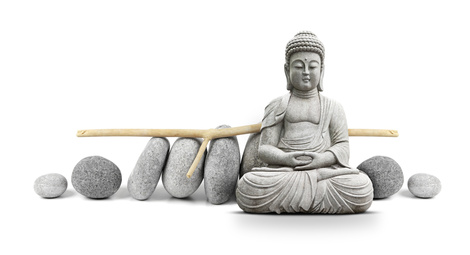The Buddha & the Four Noble Truths

The Buddha
So the Buddha left his life in his father's palace, his own
wife and child and became a wandering mendicant, bent on finding a way that
would lead him to perfect contentment and peace.
For six years, sometimes working
with other seekers, sometimes alone, he experimented with various practices,
often starving the body in the belief that by ignoring his bodily needs, his
spiritual faculties would be enhanced. He achieved some measure of success but
not the ultimate peace he was seeking.
Then he recalled a time in his youth when sitting under a
rose-apple tree he had experienced a moment of illumination which had nothing
to do with harming the body at all. And so he took another direction, realizing
that what he sought did not rely on starving the body.
At the age of thirty-five he came to a place called Bodh Gaya and sat beneath a tree, determined not to get up
until he had attained enlightenment. As he meditated, he came to understand the
nature of existence and a path that led to release from the inherent suffering
we all experience. He also saw that we are all born many times and the
conditions we are born into are depend on our deeds - good actions leading to
happy states, bad deeds leading to unhappy ones. He also realized that the idea
of a permanent self or soul was an illusion.
The Buddha now had a choice. Should he share his teaching
with the world - a teaching that he believed many would not understand - or
keep it to himself? Out of compassion, the Buddha chose the former and soon
began teaching to all those who were willing to listen. For the next forty-five
years or so, he lived as a wandering monk, amassing many followers. He died at
the age of eighty, leaving the following instruction: 'Strive on with
diligence'.
The Buddha was not a God and did not profess to be one. He was a very special human being who succeeded in finding a way to end suffering. Buddhism is often referred to as a religion without a God. This is true in that the supreme figure is the Buddha rather than a creator god such as the one in Christianity. Buddhists believe that all sentient beings have an innate spiritual component which they call "buddha nature" and try to avoid hurting or killing it in others.
The
Four Noble Truths
1.
Life is suffering.
Suffering is perhaps the most common
translation for the Sanskrit word duhkha,
which can also be translated as imperfect, stressful, or filled with anguish.
Contributing to the anguish is anitya -- the fact that all
things are impermanent, including living things like ourselves.
Furthermore, there is the concept of anatman -- literally, "no
soul". Anatman means that all things are
interconnected and interdependent, so that no thing -- including ourselves --
has a separate existence.
2.
Suffering is due to attachment .
Attachment is a common translation
for the word trishna,
which literally means thirst and is also translated as desire, clinging, greed,
craving, or lust. Because we and the world are imperfect, impermanent, and not
separate, we are forever "clinging" to things, each other, and
ourselves, in a mistaken effort at permanence. Besides attachment, there is aversion/ avoidance / hatred.
Hatred is its own kind of clinging. And finally there is ignorance or the
refusal to see. Not fully understanding the impermanence of things is what
leads us to cling in the first place.
3.
Attachment can be overcome .
Perhaps the most misunderstood term
in Buddhism is the one which refers to the overcoming of attachment: nirvana. It
literally means "blowing out," but is often thought to refer to
either a Buddhist heaven or complete nothingness. Actually, it refers to the
letting go of clinging, hatred, and ignorance, and the full acceptance of
imperfection, impermanence, and interconnectedness.
4.
There is a path for accomplishing this.
And then there is the path, called dharma.
Buddha called it the middle way, which is understood as meaning the middle way
between such competing philosophies as materialism and idealism, or hedonism
and asceticism. This path, this middle way, is elaborated as the
eightfold path.
The Eightfold Path
1. Right
view is
the true understanding of the four noble truths.
2. Right
aspiration is
the true desire to free oneself from attachment, ignorance, and hatefulness.
These two are referred to as prajña, or
wisdom.
3. Right
speech involves abstaining from lying, gossiping, or hurtful talk.
4. Right
action involves abstaining from hurtful behaviors, such as killing, stealing, and
careless sex.
5. Right
livelihood means making your living in such a way as to avoid dishonesty and hurting
others, including animals.
These three focus on morality.
6. Right
effort is
a matter of exerting oneself in regards to the content of one's mind: Bad
qualities should be abandoned and prevented from arising again; Good qualities
should be enacted and nurtured.
7. Right
mindfulness is
the focusing of one's attention on one's body, feelings, thoughts, and
consciousness in such a way as to overcome craving, hatred, and ignorance.
8. Right
concentration is
meditating in such a way as to progressively realize a true understanding of
imperfection, impermanence, and non-separateness.
The last three have to do with meditation.
" The Buddha never promoted one step such as mindfulness above the others or isolated one step from the entire Eightfold Path, but rather encouraged mindfulness to be used within the entire Eightfold Path, each step
The Three Jewels
Buddha – historical Sakyamuni Buddha
Dharma – teachings
of the Buddha; the way things are.
Sangha – originally a Buddhist monastic community, today in the West a group of people who practice buddhadharma together, usually as part of the same dharma center.
Return to Buddhist Background Reading